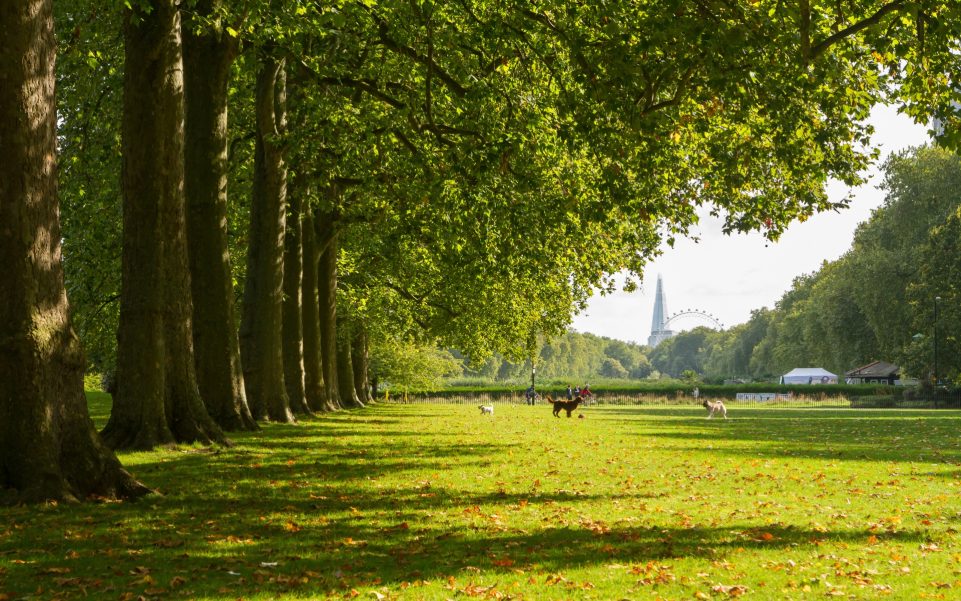London’s parks are a place for relaxation and inspiration

Many residents and visitors to the UK capital enjoy spending time in beautiful city parks. In them you can enjoy the silence and beauty of nature, forgetting for a while about the hustle and bustle of the metropolis.
In total, there are more than 3 thousand parks in London, which occupy about 18% of the total area of the city. They are visited by millions of locals and tourists every year. But what makes these parks so attractive? The answer is simple – everyone will find something to their liking in them. Connoisseurs of nature and history can stroll along the beautiful alleys and enjoy the majestic view of old architecture. At the same time, lovers of active recreation can do sports in nature, and for children there are many playgrounds and attractions.
1. Hyde Park
The greenery of centuries-old trees, the sound of fountains and children’s laughter greet visitors to Hyde Park. This oasis in the heart of the capital of United Kingdom seems to be a real refuge from the city’s rhythm of life. Time seems to stand still here, allowing you to savour the beauty and history of this unique place.
Strolling along the picturesque avenues of the former hunting ground of the royal family, acquired by Henry VIII some five centuries ago, it is impossible not to notice the diversity of its attractions. There are grandiose monuments to Queen Victoria and Prince Albert, the monumental Wellington Arch, an improvised tribune “Speakers’ Corner”, exquisite sculptures, a rose garden and much more.
The centrepiece of the park is the artificial lake Serpentine. It was created in 1730 and was named for its unusual oblong shape. Visitors can ride on the lake on boats and catamarans , feed the ducks and swans. If you wish, you can swim or even take part in regular competitions of the local swimming club.
Not far from the lake is the contemporary art gallery of the same name. Princess Diana has long been the patroness of this place. In different periods, the gallery has exhibited works by such famous artists as Man Ray, Andy Warhol and others. The Serpentine, like the park itself, is completely free for visitors to enter.
Another unique attraction in Hyde Park is the Princess Diana Memorial Fountain. The Princess Diana Memorial Fountain is a stone ring encircling a small area of the park, but it does not look like a fountain in the usual sense of the word. According to the architect Catherine Gustafson, the composition expresses the character of the Princess, embodies her personal qualities and love for children. The fountain shows the life path of the “queen of human hearts”: stone steps and a small cascade symbolise eventful years, while a slowly running stream symbolises a calm period in the princess’s life.
2. Regent’s Park
If you were planning to see all the most interesting places in London, you should definitely visit Regent’s Park! It is not for nothing that the poet Sylvia Plath called this place a “wonderland”, because here everyone can enjoy the enchanting beauty of nature and find something to do.
The park was named after the Prince Regent, the future King George IV. The Regent’s Park was designed for him by the famous architect John Nash in the Empire style, which was characterised by refinement, strict symmetry and monumentality.
The flora and fauna of the park is truly unique: there are around 5,000 species of trees, over 120 species of birds, rare species of hedgehogs and foxes. The Queen Mary Rose Garden is the largest in London and attracts a huge number of visitors each year. It houses a world-famous collection of roses – over 12,000 specimens, including the unique Royal Parks rose, which the locals are proud of.
Also in the park is the London Zoo, the oldest in the world. It was founded in 1828 and is associated with scientific research into animal life. It is home to around 17,000 different species, many of which are very rare and endangered in their natural habitat. The zoo also regularly organises various interactive events. For example, people can stay overnight in the “World of Lions” house or become part of the zoo team for a day.
Regent’s Park is a great place for outdoor enthusiasts. It is home to The Hub, the largest sports pitch in the capital, where you can hire pitches for a variety of sports. The famous local open-air theatre and boat trips on the lake are also popular with many holidaymakers.
There is also a hill adjoining the park, which offers one of the best views of London. During the reign of Elizabeth I, the hill was named Primrose Hill because in spring its slopes are covered with beautiful flowers. This picturesque part of Regent’s Park can often be seen in films such as One Hundred and One Dalmatians, Paddington, Bridget Jones: The Edge of Reason and others.
3. St. James’s Park
Three magnificent palaces – Buckingham Palace, St James’s Palace and Westminster Palace (now known as the Houses of Parliament) – surround London’s oldest royal park St James’s. Here in the shady alleys the history of Great Britain is made, with celebrations ranging from royal weddings and jubilees to grand military parades. More than 5 million people visit the park every year.
An ideal place for leisurely strolls along Lake St James and Rosamunda Pond, the park boasts many attractions. These include monuments to the Duke of York and James Cook, the famous Blue Bridge, and the magnificent Admiralty Arch. The latter was created in honour of Queen Victoria and is the main jewel of the park. Admiralty Arch holds an important place at ceremonial events: ceremonial processions pass through its centre section, while the side arches are used for traffic and pedestrians. If you look closely, on the north side of the arch you can notice a small protrusion that resembles a human nose. It is said to be dedicated to the Duke of Wellington, the famous owner of a large nose. According to tradition, military personnel touch it as they pass under the arch for good luck.
Created by the hand of designer André Mollet and architect John Nash, St James’s Park is the landscape pride of the UK. It’s hard to imagine that five centuries ago, not far from St James’s Hospital, there was a flood meadow where animals grazed peacefully. Just a century later, the Tudors settled on this land to host lavish celebrations and enjoy the spectacular jousting of knights in tournaments.
St James Park is also home to many different animals and birds. One of many attractions are the pelicans. Their beautiful plumage and proud appearance enthrals visitors. These birds were brought here in the 17th century as a gift to Charles II. It was this monarch who opened the park to the public and often socialised with his subjects there.
4. Green Park
The smallest royal park tucked away between St James’s and Hyde Parks. Today, Green Park is one of London’s quieter and more serene places but imagine the spectacle and entertainment that attracted the nobility in the 18th century! It was then that Green Park was the setting for the lavish festivities for which the eminent composer George Frideric Handel wrote Music for the Royal Fireworks. The tradition of firing fireworks in the park has survived to this day, usually on special occasions connected with important events in the life of the royal family.
Unlike other royal parks, there are almost no statues or monuments in Green Park. However, the few that are there are striking in their elegance and grandeur. One example is the black and gilded Canada Gate, which forms the front entrance to the park. They were designed by Aston Webb, the architect who worked on Buckingham Palace. Also of note is the Memorial to the Canadian soldiers who served in the British forces during the two world wars. It was unveiled in 1994 and features two granite steles dotted with bronze maple leaves, the symbol of Canada.
Another peculiarity of Green Park is that it is impossible to find a single flower bed in it. According to legend, Queen Catherine, the wife of Charles II, ordered all the flowers in the park to be plucked because of her jealousy. She didn’t want her husband to be able to give flowers to other women. Despite this, however, over a quarter of a million yellow daffodils bloom in the park every spring. These flowers, which cover the green lawns with a colourful carpet, are a kind of business card of Green Park.
5. Greenwich Park
Where can you travel from one side of the world to the other in a split second? Greenwich Park, of course! It is here that the zero meridian runs, marked by a special line. In this place there is a unique opportunity to feel simultaneously on two hemispheres of the earth. In the dark time of the day the Greenwich meridian is marked by a green laser beam in the sky. Also in 2000, a large sundial was installed in the park, which had been in the works for three years. The double horizontal dial shows not only the time but also the direction of the sun.
At the centre of Greenwich Park is the world-famous Royal Observatory, opened in the 17th century and instrumental in the creation of accurate clocks. It was there that astronomers mapped all the stars visible in both the Northern and Southern hemispheres. At the Royal Observatory you can attend interactive shows, explore the satellites of our solar system and see one of the largest telescopes in the world.
In Greenwich Park you can feel the breath of history – visitors can see the preserved part of the ancient Roman temple, burial mounds of the 6th-7th centuries on the site of the Anglo-Saxon cemetery. Also here was the palace where King Henry VIII was born. Later he married his wives here and his daughters Mary I and Elizabeth I were born. Since 1616, the park has been adorned by the Queen’s House, which now houses a priceless collection of portraits of royalty by famous masters. We recommend taking the opportunity to visit the National Maritime Museum, which is justifiably proud of its extensive collection. A day spent in Greenwich is sure to be an enlightening experience.
6. Queen’s Park
Not one of London’s royal parks, but with a truly royal name, Queens Park is a beautiful haven of calm and serenity in the turbulent flow of city life.
It was created in short order by architectural genius Alexander Mackenzie for the Royal Agricultural Society’s International Exhibition and opened in 1887 by Queen Victoria herself. Queens Park embodies all the grandeur and beauty of late Victorianism. Its style is imbued with a love of nature, expressed in the geometry of the park, where every line and element are subordinated to the principles of naturalistic landscape. The winding paths, the bold arrangements of trees and shrubs, the large open lawns for recreation and sport create a unique atmosphere, making the park an ideal place for relaxation.
Queens Park offers visitors plenty of facilities for outdoor activities. There are six tennis courts, football, rugby and pitch-and-putt, a simplified version of golf that many families love. In addition, the park has an ornamental garden with beautiful landscaping, a children’s play area and a petting zoo.
Every summer in June, the park hosts a Book Festival, which brings together national and international authors. The park also hosts a summer cinema and regular concerts on the bandstand, which has long been a trademark of the place. Created in 1891, it is a true work of art and attracts young talented musicians. In autumn, the Royal Park Day festival is traditionally held here.
London is a city that amazes residents and tourists alike with its variety of parks. Here everyone can find their ideal place for a holiday. Visiting the wonderful parks of London, you will feel the harmonious fusion of nature with the unique spirit of England.
FAQ about London’s parks
How do London's parks work?
- All parks in England’s capital city are free to enter, but please note that their opening times vary:
Hyde Park, St James’s Park and Green Park are open daily from 5am to midnight.
Regent’s Park – 5am to 5pm.
Greenwich Park – 6am to 6pm.
Queens Park – from 7am. Closing times vary depending on weather conditions and time of year.
- In all parks, cycling is allowed on designated cycle paths.
- Picnics are also allowed in parks. You can bring cooked food and both soft and alcoholic drinks into the area. However, barbecues are not allowed in the parks.
- Bathing is only allowed in a designated area in Hyde Park. Bathing is prohibited in other parks.
- If you want to take photographs in the Royal Parks or film video on your phone or action camera for personal use only, you won’t need a permit to film. But if you want to use professional equipment, then you will need a special permit from the Park Authority.
Is it possible to install a named bench in a London park?
Each year a limited number of benches in the Royal Parks become available for personalisation. For a donation to The Royal Parks charity, you can choose a spot in the park and have a bench with a plaque engraved with your unique inscription. You can dedicate it to a close friend or relative or write a favourite saying or quote from a film or book on it. Your bench will stay in the park for 10 years, and then the term can be extended. This service is available in St James’s Park, Green Park and Greenwich Park, among others.
How do I volunteer in a London park?
Anyone over the age of 18 can volunteer with The Royal Parks organisation and contribute to the improvement of the parks. As a volunteer, you can choose to be a gardener or a ranger. The former helps with the planting and maintenance of trees, shrubs and flowers, while the latter welcomes visitors, shows them the sights and introduces them to park rules and the history of the parks. No knowledge of horticulture or London’s history is required for this job – all the information you need is available at specialised training workshops. There is no payment for working in the parks, but the organisation reimburses volunteers for travel costs.





